Effects of Different Isolation Media on Structural and Functional Properties of Starches from Root Tubers of Purple, Yellow and White Sweet Potatoes
Abstract
:1. Introduction
2. Results and Discussion
2.1. Color of Starch
2.2. Protein Content in Starch
2.3. Morphology and Granule Size of Starch
2.4. Iodine Absorption Spectrum and Apparent Amylose Content of Starch
2.5. Crystalline Structure of Starch
2.6. Short-Range Ordered Structure of Starch
2.7. Lamellar Structure of Starch
2.8. Thermal Properties of Starch
2.9. Swelling Power and Water Solubility of Starch
2.10. Pasting Properties of Starch
3. Materials and Methods
3.1. Plant Materials
3.2. Starch Isolation
3.3. Color Evaluation of Starch
3.4. Measurement of Protein Content in Starch
3.5. Morphology Observation and Granule Size Analysis of Starch
3.6. Measurements of Iodine Absorption Spectrum and Apparent Amylose Content
3.7. Crystalline Structure Analysis
3.8. Short-Range Ordered Structure Analysis
3.9. Lamellar Structure Analysis
3.10. Measurement of Thermal Properties
3.11. Measurement of Swelling Power and Water Solubility
3.12. Measurement of Pasting Properties
3.13. Statistical Analysis
4. Conclusions
Author Contributions
Funding
Conflicts of Interest
References
- Bovell-Benjamin, A.C. Sweet potato: A review of its past, present, and future role in human nutrition. Adv. Food Nutr. Res. 2007, 52, 1–59. [Google Scholar] [PubMed]
- Zhu, F.; Yang, X.; Cai, Y.Z.; Bertoft, E.; Corke, H. Physicochemical properties of sweetpotato starch. Starch 2011, 63, 249–259. [Google Scholar] [CrossRef]
- Tang, Y.; Cai, W.; Xu, B. Profiles of phenolics, carotenoids and antioxidative capacities of thermal processed white, yellow, orange and purple sweet potatoes grown in Guilin, China. Food Sci. Hum. Wellness 2015, 4, 123–132. [Google Scholar] [CrossRef] [Green Version]
- Wang, S.; Pan, D.; Lv, X.; Song, X.; Qiu, Z.; Huang, C.; Huang, R.; Chen, W. Proteomic approach reveals that starch degradation contributes to anthocyanin accumulation in tuberous root of purple sweet potato. J. Proteom. 2016, 143, 298–305. [Google Scholar] [CrossRef] [PubMed]
- Tanaka, Y.; Sasaki, N.; Ohmiya, A. Biosynthesis of plant pigments: Anthocyanins, betalains and carotenoids. Plant J. 2008, 54, 733–749. [Google Scholar] [CrossRef] [PubMed]
- Chen, Z.; Schols, H.A.; Voragen, A.G.J. Physicochemical properties of starches obtained from three varieties of Chinese sweet potatoes. J. Food Sci. 2010, 68, 431–437. [Google Scholar] [CrossRef]
- Genkina, N.K.; Takahiro, N.; Koltisheva, G.I.; Wasserman, L.A.; Tester, R.F.; Yuryev, V.P. Effects of growth temperature on some structural properties of crystalline lamellae in starches extracted from sweet potatoes (Sunnyred and Ayamurasaki). Starch 2003, 55, 350–357. [Google Scholar] [CrossRef]
- Lai, Y.C.; Wang, S.Y.; Gao, H.Y.; Nguyen, K.M.; Nguyen, C.H.; Shih, M.C.; Lin, K.H. Physicochemical properties of starches and expression and activity of starch biosynthesis-related genes in sweet potatoes. Food Chem. 2016, 199, 556–564. [Google Scholar] [CrossRef] [PubMed]
- Kim, J.; Ren, C.; Shin, M. Physicochemical properties of starch isolated from eight different varieties of Korean sweet potatoes. Starch 2013, 65, 923–930. [Google Scholar] [CrossRef]
- Lee, B.H.; Lee, Y.T. Physicochemical and structural properties of different colored sweet potato starches. Starch 2016, 69, 1600001. [Google Scholar] [CrossRef]
- Osundahunsi, O.F.; Fagbemi, T.N.; Kesselman, E.; Shimoni, E. Comparison of the physicochemical properties and pasting characteristics of flour and starch from red and white sweet potato cultivars. J. Agric. Food Chem. 2003, 51, 2232–2236. [Google Scholar] [CrossRef] [PubMed]
- Senanayake, S.; Gunaratne, A.; Ranaweera, K.K.D.S.; Bamunuarachchi, A. Physico-chemical properties of five cultivars of sweet potato (Ipomea batatas Lam) roots grown in Sri Lanka. Trop. Agric. 2013, 90, 96–105. [Google Scholar]
- Abegunde, O.K.; Mu, T.H.; Chen, J.W.; Deng, F.M. Physicochemical characterization of sweet potato starches popularly used in Chinese starch industry. Food Hydrocoll. 2013, 33, 169–177. [Google Scholar] [CrossRef]
- Londoño-Restrepo, S.M.; Rincón-Londoño, N.; Contreras-Padilla, M.; Millan-Malo, B.M.; Rodriguez-Garcia, M.E. Morphological, structural, thermal, compositional, vibrational, and pasting characterization of white, yellow, and purple Arracacha lego-like starches and flours (Arracacia xanthorrhiza). Int. J. Biol. Macromol. 2018, 113, 1188–1197. [Google Scholar] [CrossRef] [PubMed]
- Lin, L.; Guo, D.; Zhao, L.; Zhang, X.; Wang, J.; Zhang, F.; Wei, C. Comparative structure of starches from high-amylose maize inbred lines and their hybrids. Food Hydrocoll. 2016, 52, 19–28. [Google Scholar] [CrossRef]
- Correia, P.R.; Nunes, M.C.; Beirão-da-Costa, M.L. The effect of starch isolation method on physical and functional properties of Portuguese nuts starches. II. Q. rotundifolia Lam. and Q. suber Lam. acorns starches. Food Hydrocoll. 2013, 30, 448–455. [Google Scholar]
- Estrada-León, R.J.; Moo-Huchin, V.M.; Ríos-Soberanis, C.R.; Betancur-Ancona, D.B.; May-Hernández, L.H.; Carrillo-Sánchez, F.A.; Cervantes-Uc, J.M.; Pérez-Pacheco, E. The effect of isolation method on properties of parota (Enterolobium cyclocarpum) starch. Food Hydrocoll. 2016, 57, 1–9. [Google Scholar] [CrossRef]
- Sun, Q.; Chu, L.; Xiong, L.; Si, F. Effects of different isolation methods on the physicochemical properties of pea starch and textural properties of vermicelli. J. Food Sci. Technol. 2015, 52, 327–334. [Google Scholar] [CrossRef]
- Baldwin, P.M. Starch granule-associated proteins and polypeptides: A review. Starch 2001, 53, 475–503. [Google Scholar] [CrossRef]
- Debet, M.R.; Gidley, M.J. Three classes of starch granule swelling: Influence of surface proteins and lipids. Carbohydr. Polym. 2006, 64, 452–465. [Google Scholar] [CrossRef]
- Wei, C.; Qin, F.; Zhu, L.; Zhou, W.; Chen, Y.; Wang, Y.; Gu, M.; Liu, Q. Microstructure and ultrastructure of high-amylose rice resistant starch granules modified by antisense RNA inhibition of starch branching enzyme. J. Agric. Food Chem. 2010, 58, 1224–1232. [Google Scholar] [CrossRef] [PubMed]
- Zhang, L.; Zhao, L.; Bian, X.; Guo, K.; Zhou, L.; Wei, C. Characterization and comparative study of starches from seven purple sweet potatoes. Food Hydrocoll. 2018, 80, 168–176. [Google Scholar] [CrossRef]
- Lin, L.; Zhang, Q.; Zhang, L.; Wei, C. Evaluation of the molecular structural parameters of normal rice starch and their relationships with its thermal and digestion properties. Molecules 2017, 22, 1526. [Google Scholar] [CrossRef] [PubMed]
- Noda, T.; Takahata, Y.; Sato, T.; Ikoma, H.; Mochida, H. Physicochemical properties of starches from purple and orange fleshed sweet potato roots at two levels of fertilizer. Starch 1996, 48, 395–399. [Google Scholar] [CrossRef]
- He, W.; Wei, C. Progress in C-type starches from different plant sources. Food Hydrocoll. 2017, 73, 162–175. [Google Scholar] [CrossRef]
- Waramboi, J.G.; Dennien, S.; Gidley, M.J.; Sopade, P.A. Characterisation of sweetpotato from Papua New Guinea and Australia: Physicochemical, pasting and gelatinisation properties. Food Chem. 2011, 126, 1759–1770. [Google Scholar] [CrossRef] [PubMed]
- Sevenou, O.; Hill, S.E.; Farhat, I.A.; Mitchell, J.R. Organisation of the external region of the starch granule as determined by infrared spectroscopy. Int. J. Biol. Macromol. 2002, 31, 79–85. [Google Scholar] [CrossRef]
- Warren, F.J.; Gidley, M.J.; Flanagan, B.M. Infrared spectroscopy as a tool to characterize starch ordered structure—A joint FTIR-ATR, NMR, XRD and DSC study. Carbohydr. Polym. 2016, 139, 35–42. [Google Scholar] [CrossRef] [PubMed]
- Blazek, J.; Gilbert, E.P. Application of small-angle X-ray and neutron scattering techniques to the characterisation of starch structure: A review. Carbohydr. Polym. 2011, 85, 281–293. [Google Scholar] [CrossRef]
- Sanderson, J.S.; Daniels, R.D.; Donald, A.M.; Blennow, A.; Engelsen, S.B. Exploratory SAXS and HPAEC-PAD studies of starches from diverse plant genotypes. Carbohydr. Polym. 2006, 64, 433–443. [Google Scholar] [CrossRef]
- Cai, C.; Cai, J.; Man, J.; Yang, Y.; Wang, Z.; Wei, C. Allomorph distribution and granule structure of lotus rhizome C-type starch during gelatinization. Food Chem. 2014, 142, 408–415. [Google Scholar] [CrossRef] [PubMed]
- Bogracheva, T.Y.; Morris, V.J.; Ring, S.G.; Hedley, C.L. The granular structure of C-type pea starch and its role in gelatinization. Biopolymers 1998, 45, 323–332. [Google Scholar] [CrossRef]
- Li, J.H.; Vasanthan, T.; Hoover, R.; Rossnagel, B.G. Starch from hull-less barley: V. In-vitro susceptibility of waxy, normal, and high-amylose starches towards hydrolysis by alpha-amylases and amyloglucosidase. Food Chem. 2004, 84, 621–632. [Google Scholar] [CrossRef]
- Rincón-Londoño, N.; Vega-Rojas, L.J.; Contreras-Padilla, M.; Acosta-Osorio, A.A.; Rodriguez-Garcia, M.E. Analysis of the pasting profile in corn starch: Structural, morphological, and thermal transformations, Part, I. Int. J. Biol. Macromol. 2016, 91, 106–114. [Google Scholar] [CrossRef] [PubMed]
- Wang, L.; Wang, Y.J. Rice starch isolation by neutral protease and high-intensity ultrasound. J. Cereal Sci. 2003, 39, 291–296. [Google Scholar] [CrossRef]
- Rodriguez-Garcia, M.E.; Londoño-Restrepo, S.M.; Ramirez-Gutierrez, C.F.; Millan-Malo, B. Effect of the crystal size on the X-ray diffraction patterns of isolated starches. arXiv, 2018; arXiv:1808.02966. [Google Scholar]
- Wei, C.; Qin, F.; Zhou, W.; Yu, H.; Xu, B.; Chen, C.; Zhu, L.; Wang, Y.; Gu, M.; Liu, Q. Granule structure and distribution of allomorphs in C-type high-amylose rice starch granule modified by antisense RNA inhibition of starch branching enzyme. J. Agric. Food Chem. 2010, 58, 11946–11954. [Google Scholar] [CrossRef] [PubMed]
Sample Availability: Samples of the starches are available from the authors. |
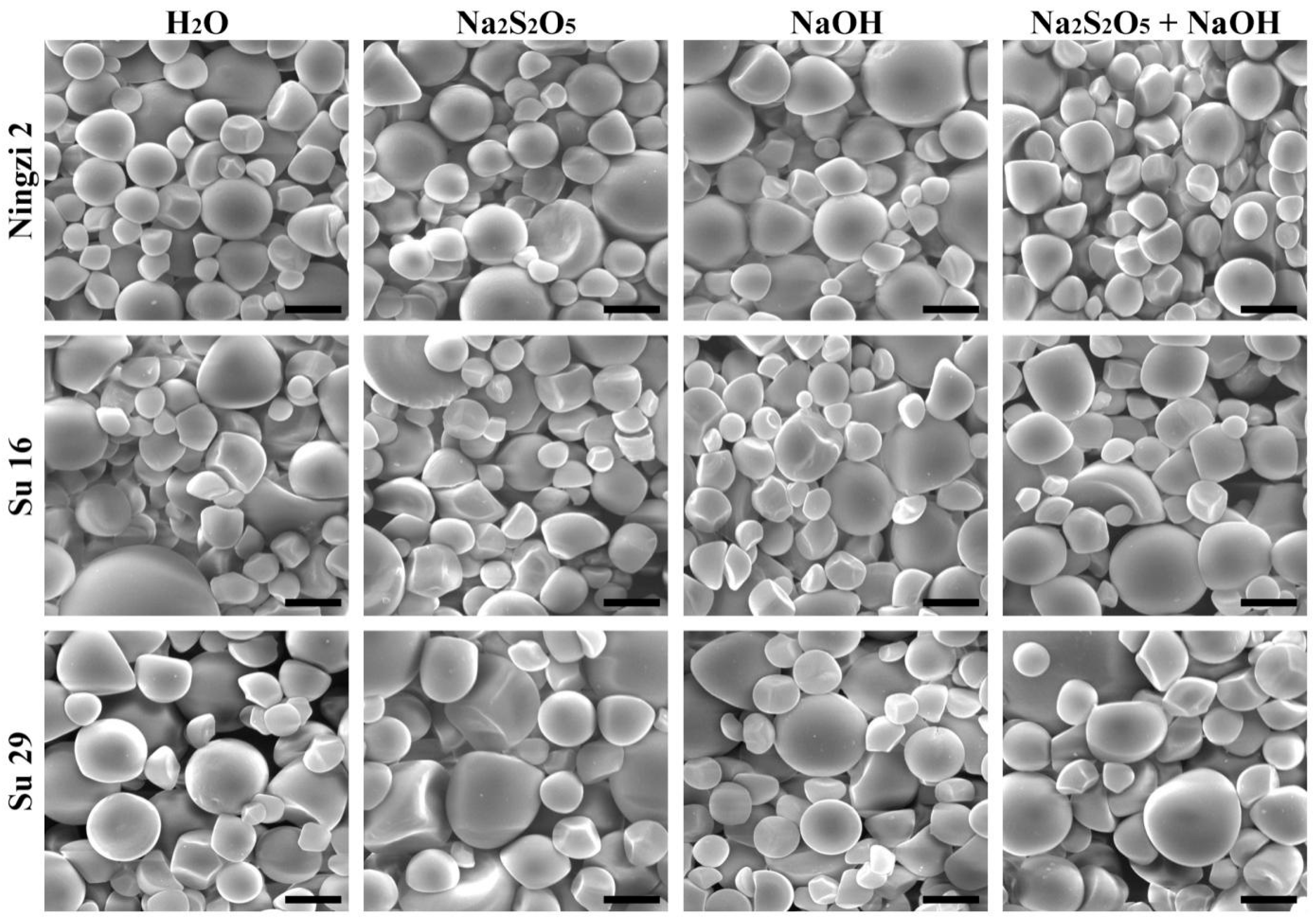
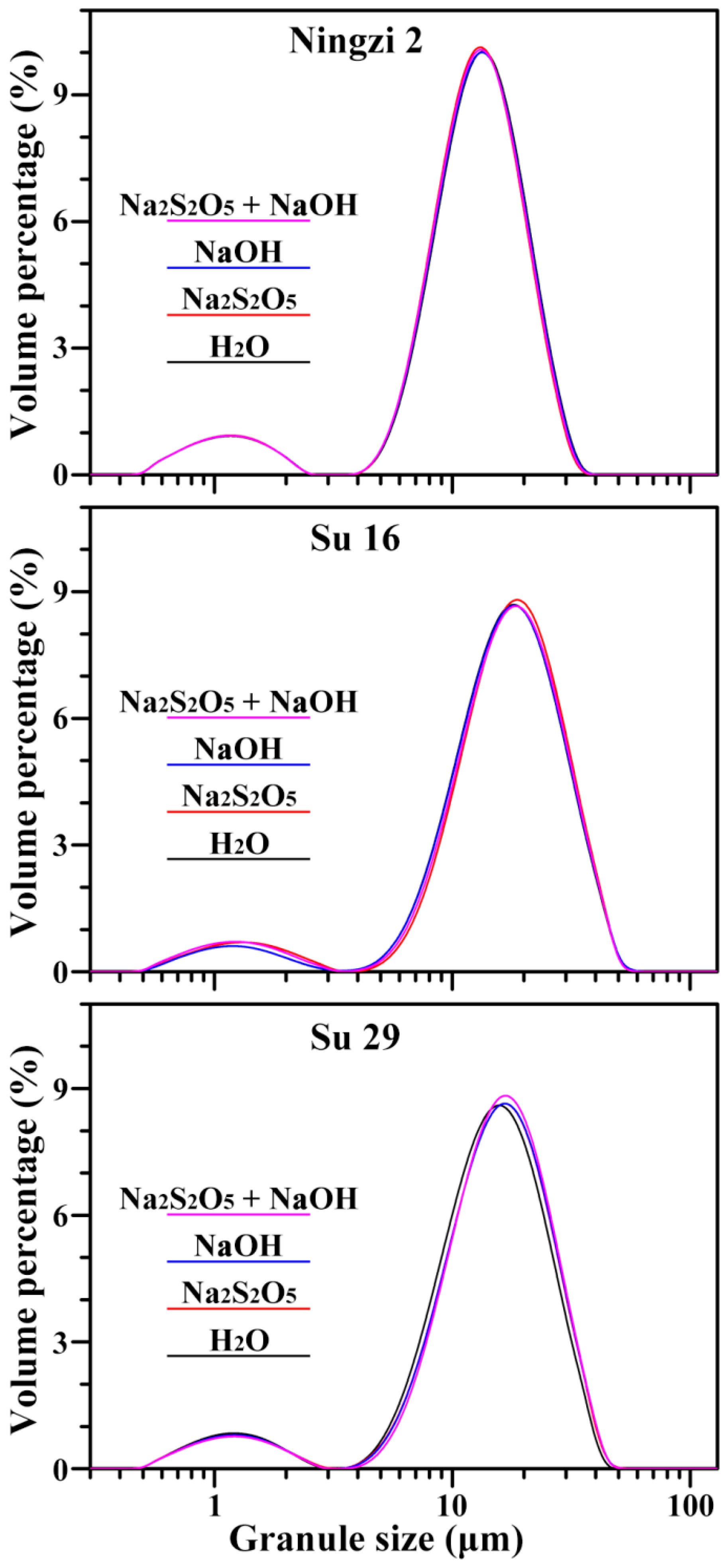

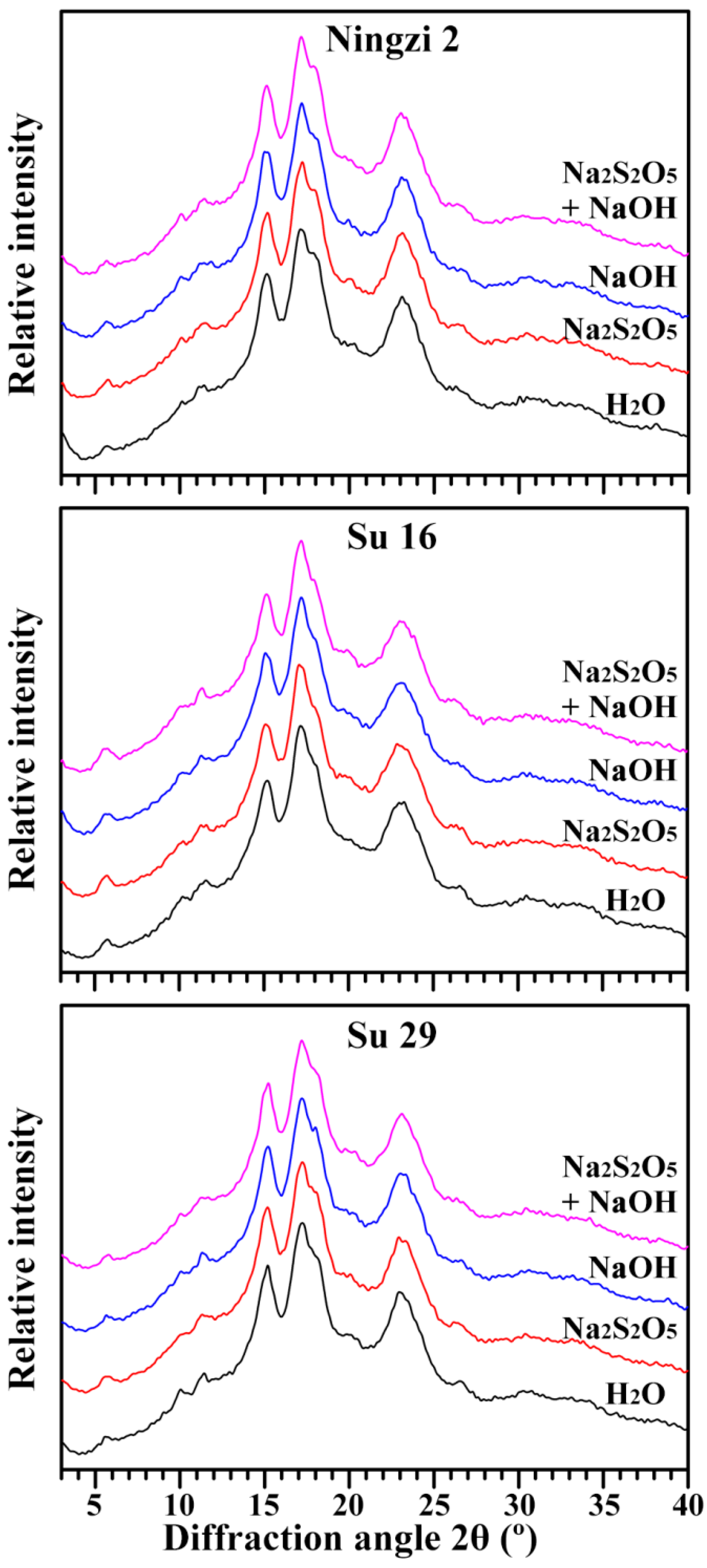
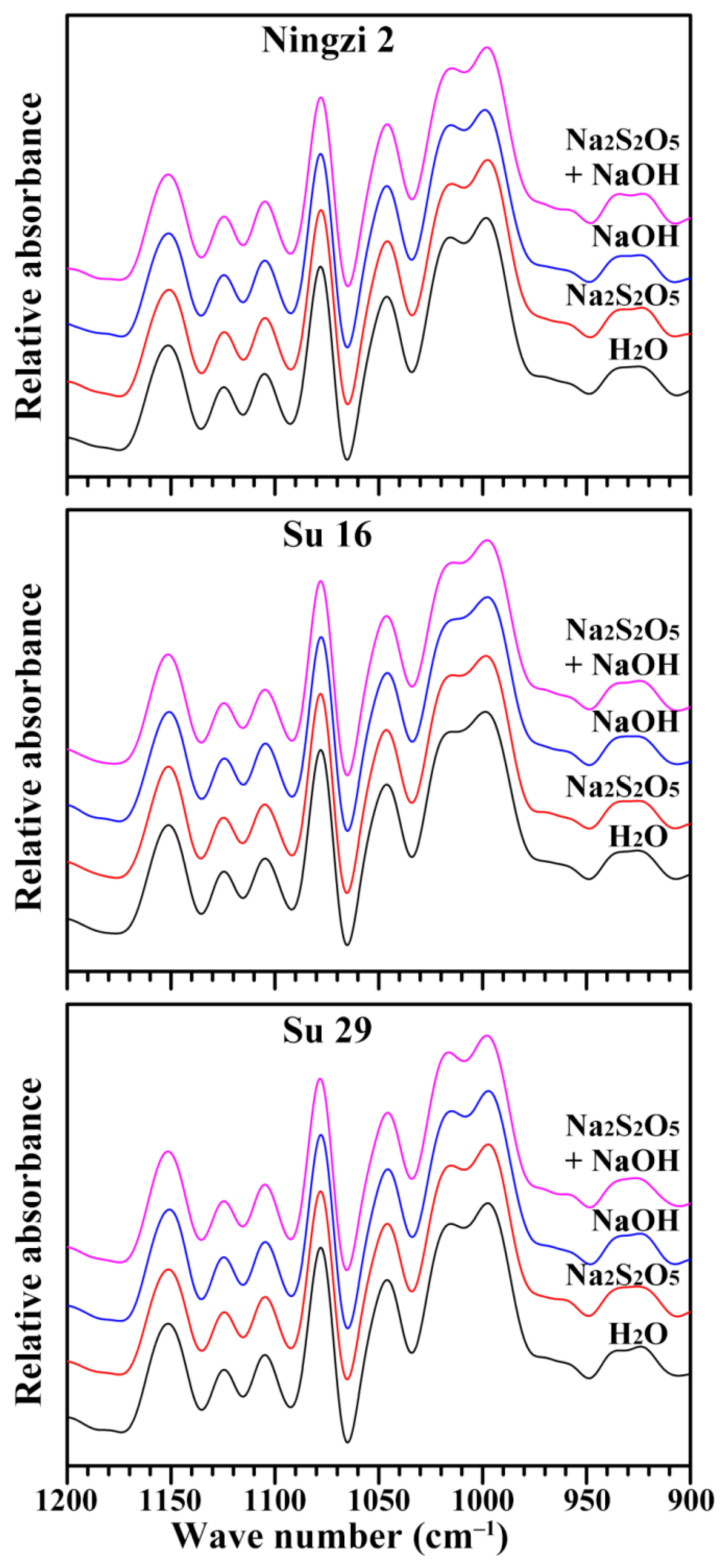

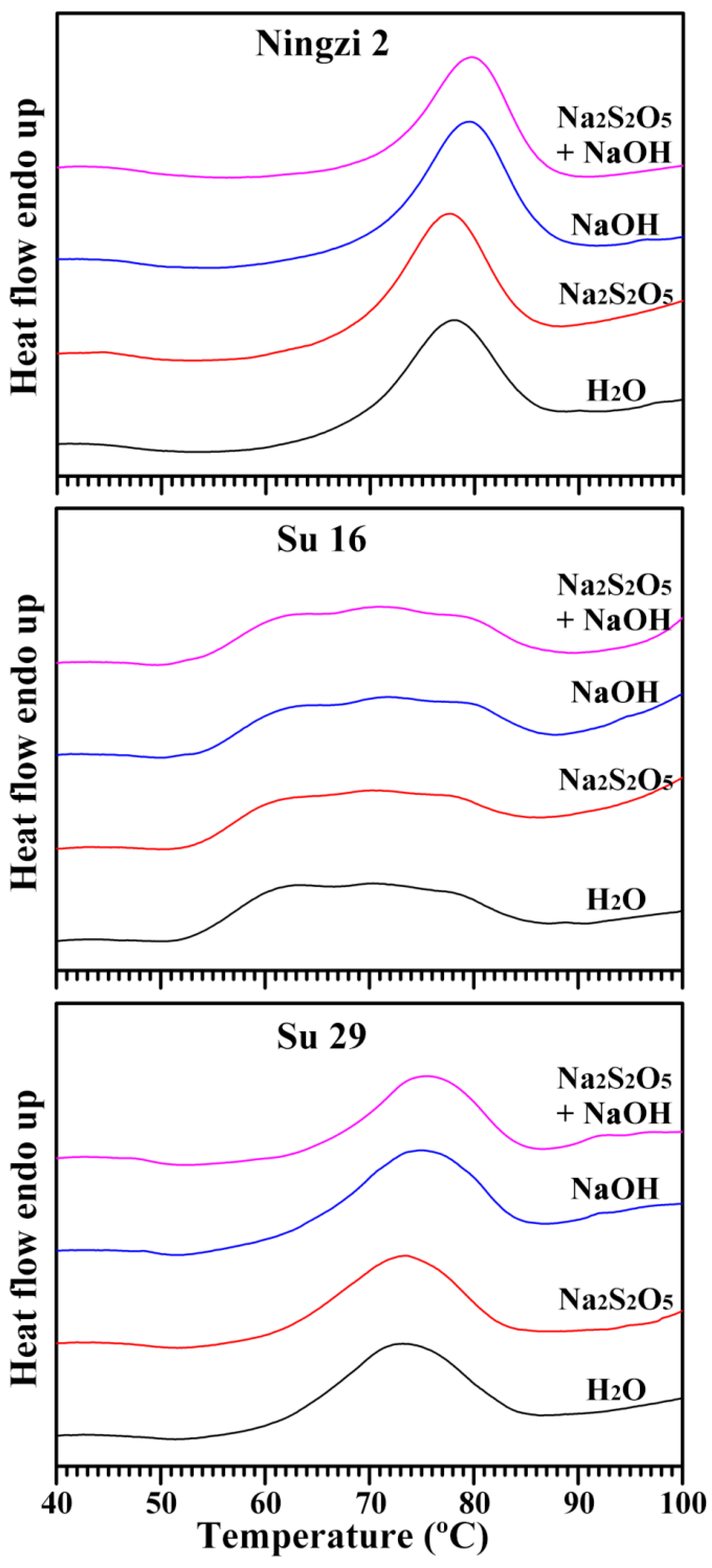
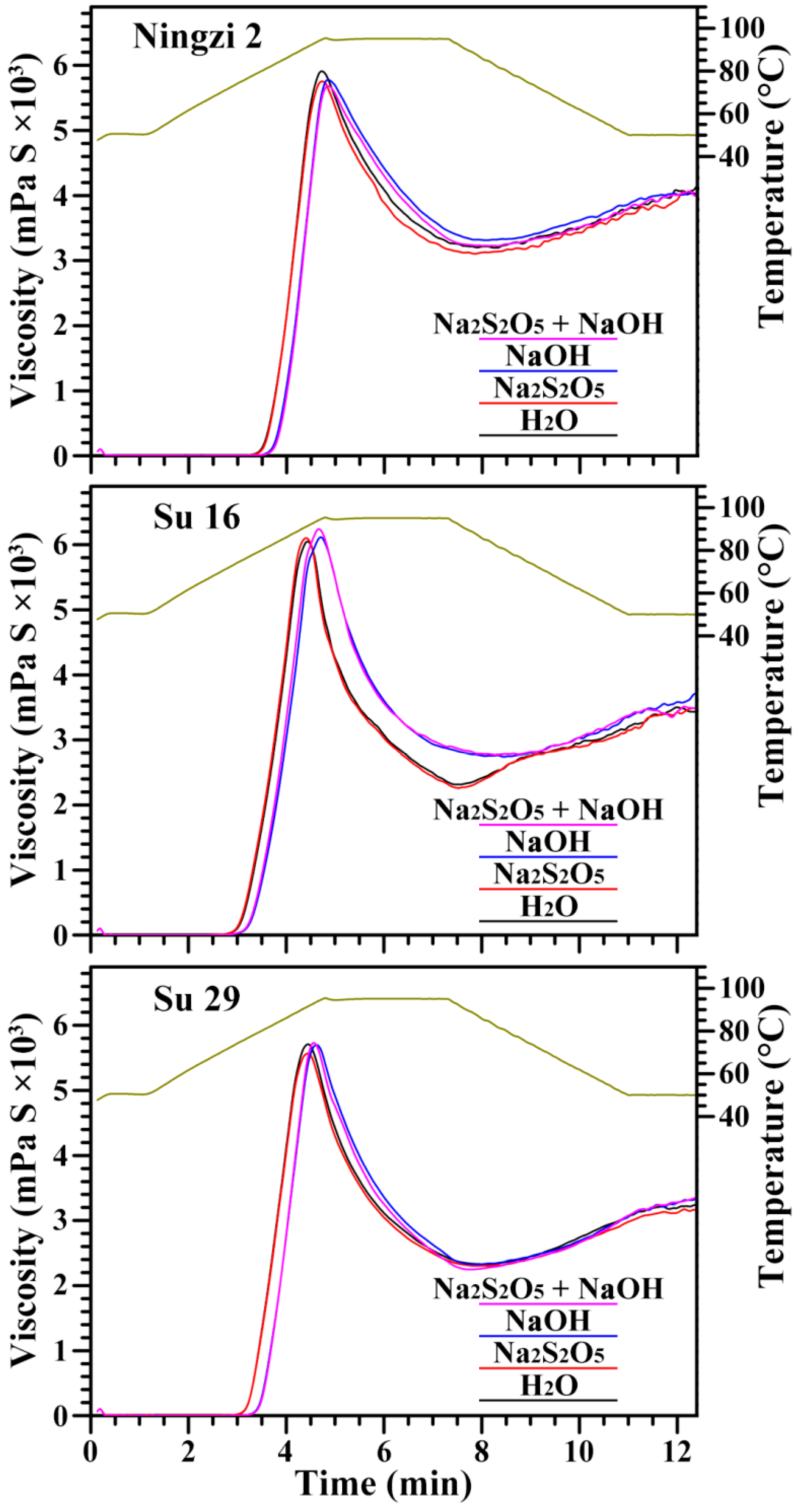
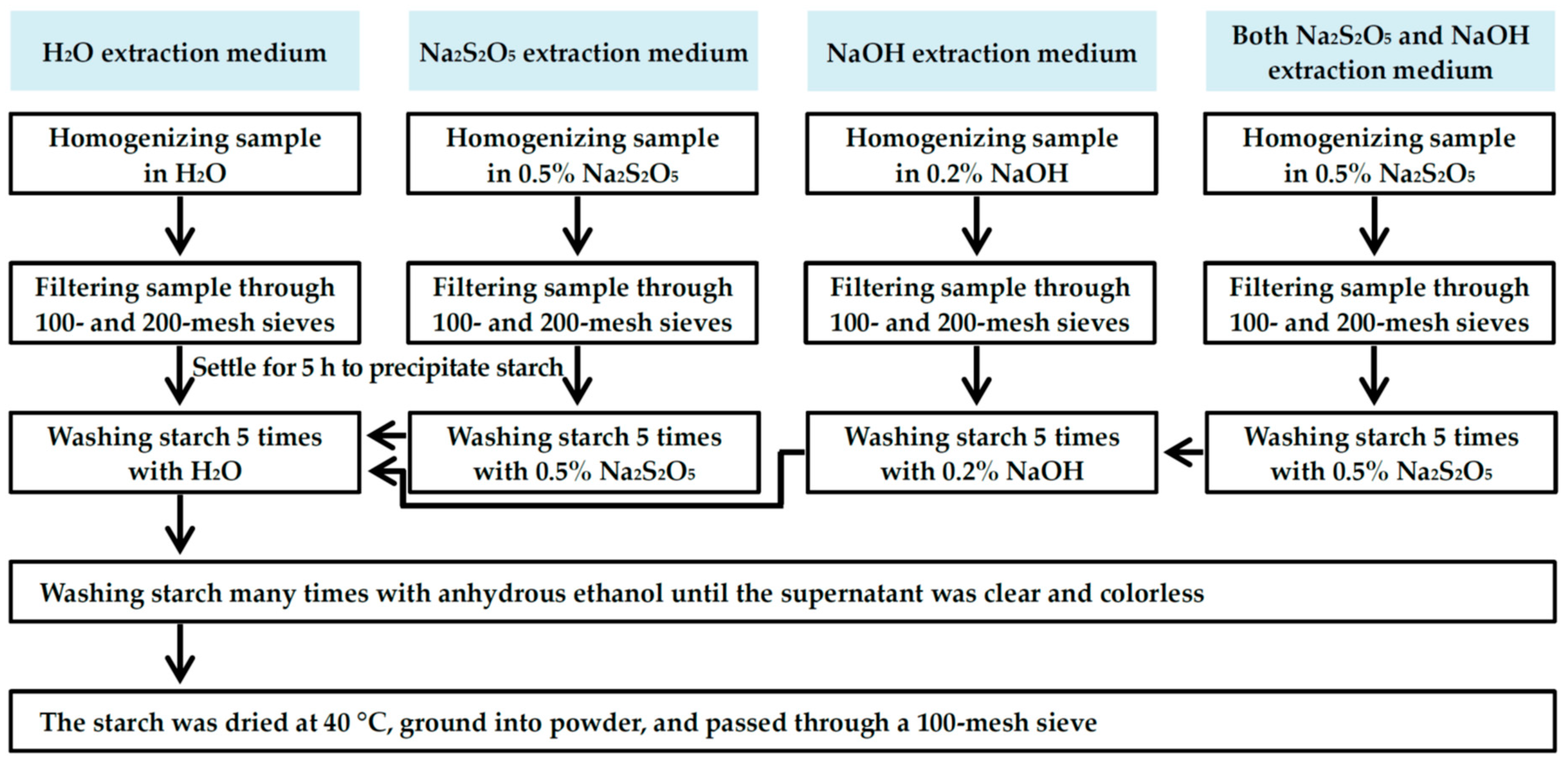
| L* | a* | b* | PC (mg/g) | |
|---|---|---|---|---|
| Ningzi 2 | ||||
| H2O | 93.76 ± 0.16 a | −0.10 ± 0.00 d | +3.99 ± 0.04 b | 0.69 ± 0.00 a |
| Na2S2O5 | 94.71 ± 0.17 b | −0.22 ± 0.01 c | +3.20 ± 0.03 a | 0.69 ± 0.00 a |
| NaOH | 94.70 ± 0.28 b | −0.65 ± 0.02 a | +3.21 ± 0.06 a | 0.59 ± 0.04 a |
| Na2S2O5 + NaOH | 95.20 ± 0.03 c | −0.60 ± 0.01 b | +3.20 ± 0.08 a | 0.59 ± 0.04 a |
| Su 16 | ||||
| H2O | 95.45 ± 0.38 a | −0.29 ± 0.02 c | +1.74 ± 0.07 b | 0.56 ± 0.09 a |
| Na2S2O5 | 96.37 ± 0.02 b | −0.23 ± 0.01 d | +1.41 ± 0.07 a | 0.59 ± 0.04 a |
| NaOH | 96.24 ± 0.23 b | −0.57 ± 0.01 a | +2.36 ± 0.03 d | 0.59 ± 0.04 a |
| Na2S2O5 + NaOH | 96.21 ± 0.17 b | −0.41 ± 0.01 b | +2.00 ± 0.03 c | 0.56 ± 0.09 a |
| Su 29 | ||||
| H2O | 96.31 ± 0.22 a | −0.24 ± 0.01 c | +1.95 ± 0.06 d | 0.72 ± 0.13 a |
| Na2S2O5 | 96.32 ± 0.26 a | −0.10 ± 0.01 d | +0.96 ± 0.04 a | 0.66 ± 0.04 a |
| NaOH | 96.41 ± 0.28 a | −0.39 ± 0.01 a | +1.64 ± 0.05 c | 0.56 ± 0.00 a |
| Na2S2O5 + NaOH | 96.87 ± 0.05 a | −0.33 ± 0.01 b | +1.24 ± 0.05 b | 0.56 ± 0.00 a |
| d(0.1) (μm) | d(0.5) (μm) | d(0.9) (μm) | D[4, 3] (μm) | |
|---|---|---|---|---|
| Ningzi 2 | ||||
| H2O | 5.517 ± 0.001 d | 11.937 ± 0.004 d | 20.294 ± 0.014 d | 12.361 ± 0.006 d |
| Na2S2O5 | 5.443 ± 0.002 a | 11.662 ± 0.002 a | 19.733 ± 0.004 a | 12.056 ± 0.002 a |
| NaOH | 5.457 ± 0.001 c | 11.830 ± 0.002 c | 20.138 ± 0.005 c | 12.254 ± 0.002 c |
| Na2S2O5 + NaOH | 5.452 ± 0.001 b | 11.726 ± 0.003 b | 19.901 ± 0.004 b | 12.136 ± 0.003 b |
| Su 16 | ||||
| H2O | 7.214 ± 0.002 c | 15.960 ± 0.004 a | 29.420 ± 0.017 a | 17.138 ± 0.008 a |
| Na2S2O5 | 7.135 ± 0.003 b | 16.395 ± 0.007 d | 29.871 ± 0.021 d | 17.422 ± 0.009 d |
| NaOH | 7.228 ± 0.002 d | 16.038 ± 0.003 b | 29.612 ± 0.012 b | 17.234 ± 0.005 c |
| Na2S2O5 + NaOH | 6.869 ± 0.000 a | 16.126 ± 0.002 c | 29.653 ± 0.012 c | 17.181 ± 0.004 b |
| Su 29 | ||||
| H2O | 5.654 ± 0.005 a | 13.606 ± 0.008 a | 25.039 ± 0.019 a | 14.472 ± 0.009 a |
| Na2S2O5 | 5.881 ± 0.016 b | 14.254 ± 0.001 b | 26.072 ± 0.009 b | 15.117 ± 0.002 b |
| NaOH | 5.957 ± 0.001 c | 14.304 ± 0.002 c | 26.176 ± 0.011 c | 15.182 ± 0.004 c |
| Na2S2O5 + NaOH | 6.291 ± 0.003 d | 14.514 ± 0.004 d | 26.278 ± 0.001 d | 15.371 ± 0.002 d |
| λmax (nm) | OD620/550 | AAC (%) | |
|---|---|---|---|
| Ningzi 2 | |||
| H2O | 607 ± 1 b | 1.14 ± 0.02 a | 26.0 ± 0.4 a |
| Na2S2O5 | 603 ± 1 ab | 1.14 ± 0.01 a | 25.9 ± 0.9 a |
| NaOH | 604 ± 1 ab | 1.14 ± 0.01 a | 25.7 ± 0.8 a |
| Na2S2O5 + NaOH | 602 ± 2 a | 1.13 ± 0.00 a | 25.7 ± 0.4 a |
| Su 16 | |||
| H2O | 603 ± 1 a | 1.13 ± 0.01 a | 29.4 ± 0.7 a |
| Na2S2O5 | 602 ± 2 a | 1.12 ± 0.02 a | 29.0 ± 1.2 a |
| NaOH | 605 ± 2 a | 1.14 ± 0.01 a | 28.3 ± 0.7 a |
| Na2S2O5 + NaOH | 603 ± 1 a | 1.13 ± 0.00 a | 29.8 ± 0.7 a |
| Su 29 | |||
| H2O | 611 ± 1 b | 1.19 ± 0.02 a | 29.2 ± 0.8 a |
| Na2S2O5 | 608 ± 1 a | 1.17 ± 0.00 a | 30.2 ± 0.6 a |
| NaOH | 609 ± 1 ab | 1.17 ± 0.01 a | 28.8 ± 0.8 a |
| Na2S2O5 + NaOH | 611 ± 1 b | 1.19 ± 0.01 a | 28.8 ± 1.0 a |
| To (°C) | Tp (°C) | Tc (°C) | ΔTo (°C) | ΔH (J/g) | |
|---|---|---|---|---|---|
| Ningzi 2 | |||||
| H2O | 68.9 ± 0.3 a | 78.0 ± 0.1 a | 85.5 ± 0.4 a | 16.6 ± 0.7 a | 11.3 ± 0.5 a |
| Na2S2O5 | 68.5 ± 0.1 a | 77.7 ± 0.1 a | 85.1 ± 0.4 a | 16.6 ± 0.5 a | 12.1 ± 0.4 ab |
| NaOH | 70.0 ± 0.4 b | 79.5 ± 0.1 b | 86.6 ± 0.3 b | 16.7 ± 0.1 a | 13.1 ± 0.0 b |
| Na2S2O5 + NaOH | 70.4 ± 0.1 b | 79.6 ± 0.2 b | 86.9 ± 0.5 b | 16.5 ± 0.6 a | 13.4 ± 0.1 b |
| Su 16 | |||||
| H2O | 54.0 ± 0.1 c | 70.3 ± 0.1 a | 84.6 ± 0.1 ab | 30.7 ± 0.2 a | 9.4 ± 0.1 a |
| Na2S2O5 | 53.3 ± 0.1 a | 70.1 ± 0.1 a | 83.9 ± 0.4 a | 30.6 ± 0.4 a | 9.2 ± 0.1 a |
| NaOH | 53.5 ± 0.0 ab | 71.7 ± 0.6 b | 86.4 ± 0.8 c | 32.9 ± 0.8 b | 10.4 ± 0.0 b |
| Na2S2O5 + NaOH | 53.6 ± 0.1 b | 71.1 ± 0.0 ab | 85.9 ± 0.2 bc | 32.3 ± 0.4 ab | 11.0 ± 0.3 c |
| Su 29 | |||||
| H2O | 61.2 ± 0.1 a | 73.3 ± 0.0 a | 82.9 ± 0.6 a | 21.8 ± 0.6 a | 9.3 ± 0.1 a |
| Na2S2O5 | 60.9 ± 0.1 a | 73.3 ± 0.1 a | 83.1 ± 0.1 a | 22.2 ± 0.0 a | 10.4 ± 0.1 b |
| NaOH | 62.4 ± 0.1 ab | 75.1 ± 0.1 b | 84.3 ± 0.1 a | 22.0 ± 0.2 a | 10.8 ± 0.0 b |
| Na2S2O5 + NaOH | 63.3 ± 0.9 b | 75.4 ± 0.3 b | 84.6 ± 0.9 a | 21.3 ± 0.0 a | 11.2 ± 0.6 b |
| Ningzi 2 | Su 16 | Su 29 | ||||
|---|---|---|---|---|---|---|
| SP (g/g) | WS (%) | SP (g/g) | WS (%) | SP (g/g) | WS (%) | |
| H2O | 26.9 ± 0.3 ab | 11.1 ± 0.4 a | 32.4 ± 0.6 bc | 12.8 ± 0.4 a | 28.2 ± 0.1 a | 17.1 ± 0.2 b |
| Na2S2O5 | 27.5 ± 0.3 b | 11.3 ± 0.4 a | 33.4 ± 0.3 c | 14.0 ± 2.2 a | 28.0 ± 0.1 a | 17.2 ± 0.7 b |
| NaOH | 26.1 ± 0.6 a | 11.0 ± 0.5 a | 30.2 ± 0.6 a | 13.6 ± 0.4 a | 28.1 ± 0.7 a | 15.9 ± 0.3 a |
| Na2S2O5 + NaOH | 27.0 ± 0.5 ab | 11.0 ± 0.3 a | 32.1 ± 0.6 b | 13.4 ± 0.4 a | 29.0 ± 0.7 a | 15.9 ± 0.5 a |
| PV (mPa S) | HV (mPa S) | BV (mPa S) | FV (mPa S) | SV (mPa S) | PT (°C) | |
|---|---|---|---|---|---|---|
| Ningzi 2 | ||||||
| H2O | 5918 ± 85 b | 3167 ± 87 a | 2751 ± 72 b | 4103 ± 27 a | 936 ± 80 b | 78.2 ± 0.1 a |
| Na2S2O5 | 5763 ± 50 a | 3092 ± 21 a | 2670 ± 52 b | 4053 ± 54 a | 961 ± 40 b | 78.5 ± 0.6 a |
| NaOH | 5804 ± 29 ab | 3308 ± 36 b | 2495 ± 12 a | 4027 ± 84 a | 719 ± 78 a | 80.8 ± 0.5 b |
| Na2S2O5 + NaOH | 5695 ± 66 a | 3213 ± 57 ab | 2482 ± 43 a | 4030 ± 40 a | 817 ± 43 ab | 81.6 ± 0.4 b |
| Su 16 | ||||||
| H2O | 6054 ± 55 a | 2309 ± 88 a | 3745 ± 66 b | 3466 ± 77 a | 1157 ± 63 c | 73.1 ± 0.5 a |
| Na2S2O5 | 6143 ± 80 ab | 2322 ± 46 a | 3821 ± 46 b | 3625 ± 10 ab | 1303 ± 55 c | 73.0 ± 0.5 a |
| NaOH | 6134 ± 33 ab | 2730 ± 12 b | 3404 ± 26 a | 3711 ± 90 b | 980 ± 87 b | 75.2 ± 0.4 b |
| Na2S2O5 + NaOH | 6261 ± 62 b | 2762 ± 52 b | 3499 ± 48 a | 3487 ± 68 a | 725 ± 86 a | 75.0 ± 0.1 b |
| Su 29 | ||||||
| H2O | 5726 ± 10 a | 2328 ± 39 a | 3398 ± 29 b | 3268 ± 29 b | 940 ± 41 a | 74.7 ± 0.5 a |
| Na2S2O5 | 5579 ± 62 a | 2297 ± 43 a | 3282 ± 42 a | 3133 ± 52 a | 836 ± 77 a | 74.8 ± 0.4 a |
| NaOH | 5714 ± 86 a | 2313 ± 59 a | 3401 ± 28 b | 3302 ± 50 b | 989 ± 58 ab | 77.6 ± 0.4 b |
| Na2S2O5 + NaOH | 5756 ± 98 a | 2245 ± 50 a | 3511 ± 68 c | 3352 ± 31 b | 1107 ± 79 b | 77.7 ± 0.4 b |
© 2018 by the authors. Licensee MDPI, Basel, Switzerland. This article is an open access article distributed under the terms and conditions of the Creative Commons Attribution (CC BY) license (http://creativecommons.org/licenses/by/4.0/).
Share and Cite
Xu, A.; Guo, K.; Liu, T.; Bian, X.; Zhang, L.; Wei, C. Effects of Different Isolation Media on Structural and Functional Properties of Starches from Root Tubers of Purple, Yellow and White Sweet Potatoes. Molecules 2018, 23, 2135. https://doi.org/10.3390/molecules23092135
Xu A, Guo K, Liu T, Bian X, Zhang L, Wei C. Effects of Different Isolation Media on Structural and Functional Properties of Starches from Root Tubers of Purple, Yellow and White Sweet Potatoes. Molecules. 2018; 23(9):2135. https://doi.org/10.3390/molecules23092135
Chicago/Turabian StyleXu, Ahui, Ke Guo, Tianxiang Liu, Xiaofeng Bian, Long Zhang, and Cunxu Wei. 2018. "Effects of Different Isolation Media on Structural and Functional Properties of Starches from Root Tubers of Purple, Yellow and White Sweet Potatoes" Molecules 23, no. 9: 2135. https://doi.org/10.3390/molecules23092135





